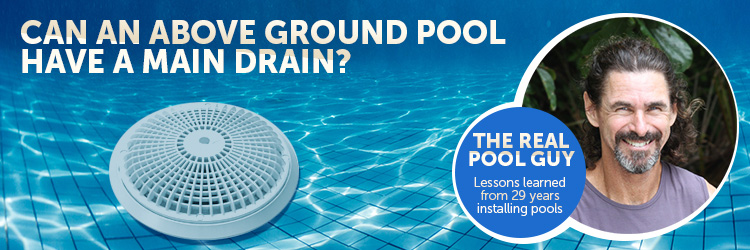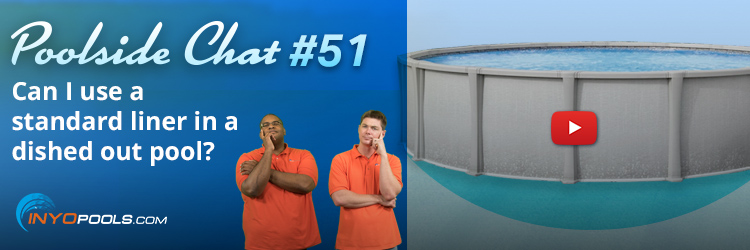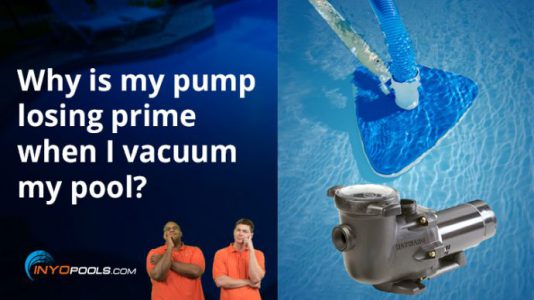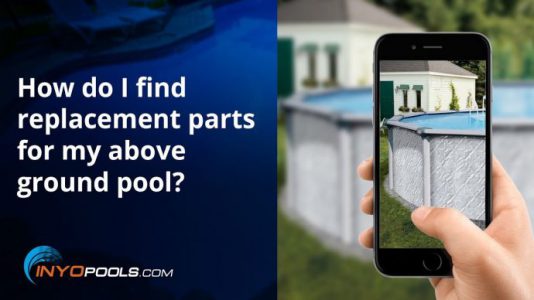Fortunately for all of us, above ground swimming pools now mostly come with decent equipment at least. What I mean by “equipment” is a pump and filter. Many years back, above grounds only came with really crappy canister sand filters and undersized pumps. They came with them to keep the cost down and who cared anyway. It was just an above ground pool. What do you expect?
Now, just about all the middle-of-the-road and higher end above grounds will have more than big enough pumps and filters and they are built to last many years. This is great, but there’s something that hasn’t changed with above ground pools and that is the skimmer and return openings in the wall. These openings are where the pump and filter hook up to the pool and they are both located high up and right next to each other.
This is not great for water circulation as the pool water is brought into the equipment by way of the skimmer box, gets filtered, and then the clean water returns to the pool through a fitting that is right next to the skimmer. So, you could have a 24’ round pool that is about four feet deep and have a great pump and filter, but it can only draw pool water in from the pool’s surface and then send it back to the pool right next to where it came from. What about the rest of the water in the pool especially the water at the bottom? How does that pool water get through the pump and filter?
With above grounds there is always the potential for all the water not to be making it evenly through the equipment and therefore causing chemical balance issues due to poor circulation. There are three ways an above ground pool can get better circulation. You could get and use an automatic pool cleaner, add a return line or two, or you could have a center bottom main drain. Out of these three options, the main drain is clearly my favorite so that is what I’m going to go over in this blog post.

Main Drains (They’re Not Just for In-grounds)
When you consider getting an above ground pool, you’ll get a few upgrades or options to choose from to make the pool better or easier to take care of. A main drain won’t be one of them as they would be hard to sell as a kit and wouldn’t be profitable enough for retailers. As a result, many who get an above ground pool and are willing to spend more for extra things never even hear about a main drain.
Everyone seems to know that all in-ground pools have main drains, but it occurs to just a few that vinyl lined above grounds can have them too. And, they are great for keeping the pool cleaner and for much better circulation. It does take more than a screwdriver and duct tape to install one, so unless you have some plumbing knowledge, you do-it-yourselfers should maybe leave installing one to the pool installer.
Installing a Main Drain
As stated above, installing a main drain in an above ground pool on your own may not be the best idea as it takes some doing. First off, a main drain requires that the liner gets cut in order for the water to travel to the filter and that’s always a scary proposition. Though, it can be done fairly easily if you know how. Installing a main drain won’t be the hardest thing you’ve ever done that you didn’t know much about, but it’s that whole “cutting-a-hole-in-the-liner” thing that is spooky. And, it should be as having a leaking pool really sucks. So, if I didn’t deter you enough and you want to attempt it, here are step-by-step instructions to help you hopefully get it right.
Materials needed:
- One main drain for vinyl pools. I say one, because they will come in packs of two as in some places, the code is to install two main drains.
- Approximately 20 feet of 1.5” schedule 40 PVC pipe.
- At least three 1.5” male threaded to slip, one 1.5” coupling, three 1.5” elbows, and one 1.5” tee PVC fitting.
- Medium PVC glue, 100% silicone, a hacksaw, a tape measure, a shovel, and a torpedo level (if you want it to look good).
- Two 1.5” PVC ball valves.
- A sharp utility blade, duct tape, and a #3 Phillips screwdriver.
I. Dig the trench
Measure in from the pool track or wall in three different places to determine the center of the pool. Example: For a 24’ round pool, measure in 12’. Mark the center and dig a trench toward the right side of where the pool skimmer is. You won’t want to dig too deep as the drain should be installed level which doesn’t allow you to bury the piping very deep.
II. Prepare the main drain
Silicone in the bottom threaded plug and silicone the threaded male to slip fitting and glue a full piece of pipe to it. Important: Duct tape the entire top opening of the main drain with the bottom gasket in place and lined up with all the screw holes. The duct tape should be one uniform layer. Doing this will completely cover the inside of the drain and its screw holes.
III. Set the main drain
Place the main drain with its attached pipe in place. Use a torpedo level and use your hands to pack the earth around it until it is firm. Use a patio block underneath it so that it has something firm to rest on.
IV. Continue with the piping
Once the main drain is set you’ll have the pipe it’s attached to in the trench you dug, but it won’t be complete. Continue plumbing by adding more of the pipe to go out of the pool’s bottom and then glue a piece upward toward the pool’s pump. Once all the piping in the trench is set and glued, go ahead and bury it. This will leave only the pipe that’s sticking up outside of the pool visible.
V. Plumb in the valve
Glue in one of the ball valves to the pipe that is now coming from your main drain. You can glue it vertically or for a nicer look, glue it horizontally. Now continue piping your line beyond the valve that you have just installed and head towards the pump.
VI. Connect the line to the pump and skimmer
You are almost done, but this is the hardest plumbing part. Locate the pool’s skimmer and plumb PVC piping from the bottom of it towards the pump and add the other ball valve to that line. You should now have two PVC lines, each with valves, heading toward the front of the pool pump. Using a “tee” fitting, connect the two lines to the pump with piping.
Try to make it look straight and nice, if you can. If you can’t, it’s no big deal. It’ll still work as long as you have glued every fitting well. Yeah, you want to make sure you glue everything properly. You can now finish installing the pool’s liner.
VII. Cutting in the main drain (Yikes!)
Now it’s time for the hard part. Just kidding. Cutting for the main drain is really easy. Stressful, but easy. Set your pool’s liner and get all the wrinkles out whatever way YouTube tells you and start filling with water. Let the pool fill at least a few inches or more. As the pool fills, you’ll start to see where the top of the main drain is at the bottom of the pool. The weight of the water will press down and the main drain’s screw holes will become visible.
ALERT: Don’t cut anything yet! When you can see the screw holes, take the main drain ring and gasket and carefully screw the ring down onto the main drain. Screw directly through the liner. There are about 10 screws so get that ring screwed down tightly all the way around.
Once the ring is firmly screwed in place, cut the liner along the inside of the ring and remove. You should now see the inside of the drain. Now you can screw down the lid and you’re done. Congratulations, you did it! The only thing left to do is pray you have glued everything right.











This is appalling. Main drains in above-ground pools are not needed. If they were powerful enough to change the make up of the water going to the pump they would be dangerous in suction strength. Also, suction has no effect on circulation. Physics 101. Any submerged suction outlet is a danger for entrapment, not only suction but mechanical (necklace, string etc.), hair (it wraps around on the backside …think of a whirlpool), and limb ( a foot breaks a cover or it is missing and a small foot gets caught inside the sump pot and the person cannot get head above water to breath). Dual drains are no better as they double the chance of entrapment. There are better options to increase water circulation patterns but suction has no part and this is a myth. Poor blog to publish, and negligent in safety.
You need some education. You’re dead wrong. We had a center drain on a 21 foot above ground pool and we almost NEVER had to vacuum or skim the top. All debris would move around to the center of the pool and get sucked down through the floor drain. Even “physicists” like you don’t know everything.
Indeed!! Ours is the same, practically Never! They are wonderful
Drain for sure ,of course
We have not forgotten about physics but it appears you have forgotten about the pool industry-wide switch to anti-vortex main drains around 2008 due to the Virginia Graeme Baker Act. The act made it illegal to install non- antivortex main drains, and most pool owners if not all have retrofit to the new safe style of main drains. The points about someone being trapped to the drain grate are valid but also antiquated considering the current rules and technology.
It’s people like you Miss Wendy that create more conflict and disinformation campaigns with your overly hyper focused safety NOSE in everyone else’s business . Furthermore , IF , I say IF , you just HAVE to comment about something negatively , at LEAST bring and add the scientific data that proves it to be incorrect AND an alternative option for the people you are saying “Don’t do this ” for . Mind your own business , and we won’t mention to others the rhetorical assumption that people like yourself probably don’t even own a pool .
Main drains in above ground pools is the way to go! I will never have a pool without one!!
I disagree. I have a main drain in the bottom of my above ground pool and it is no less safe than the one in my below ground pool at my other property. The main drain in my above ground pool absolutely serves to circulate as well. Water can be sucked through the bottom main drain and is circulated through the pump and jetted back out into the pool. I like having a main drain and back wash, etc. just like I do on my below ground pool and it makes for easy draining of the above ground pool if needed.
Are you sure your name isn’t Karen ????
I had over ground pool that was removed but on one side of the house I always have accumulation of water that drain on grass when installing a pool possible break water line???
So the single layer (no overlaps) of duct tape placed over the main drain body to keep sand out of the screw holes remains in place after installation? Only the center of the duct tape layer is removed when the liner is cut out of the middle?
I’m also confused about this. I understand the need to keep the screw holes covered to keep sand out. Will this duct tape interfere with the gasket sealing?
Dan,
I have an above-ground pool that is set in the ground and has a 6′ deep end. By installing a main drain, will that require changing the pump to an inground pump for priming purposes? In the current installation, the existing above-ground pump is approximately 18″ below the skimmer.
Yes because the above ground is not self priming
I’m puzzled as to how the main drains get installed when they are installed in the virgin dirt and then 3″ of sand goes on top as the pool base. Do I have to slope some of the sand into the drain and then lay liner on top so I can see the screw holes after some filling?
Hi. I just bought an 18′ x 33′ oval pool. I am going to install a main drain in hopes that the circulation will be better than in my previous 24′ round pool which was SO hard to keep clean!
I see you recommend Hayward. Do the drains come in different sizes? If so, what would be the appropriate size for this size pool? I know you said to install one. Is one better than 2? Or would it be better to have one at each end? I really want an easy to keep clean pool. I battled with the other one for years and spent more on chemicals than the pool was worth. Any advice would be most appreciated. Thank you.
Dan, do you happen to have a picture or image of the plumbing at the pump and skimmer? I am going to replace my liner this week and am strongly considering a main drain. Thanks for the great article!
Dan, do you happen to have a picture or image of the plumbing at the pump and skimmer? I am going to replace my liner this week and am strongly considering a main drain. Thanks for the great article!
In reading your responses, I laughed out loud multiple times. Thanks for that.
We have a 21×43 above ground Sentinelle pool and we are changing the liner in a few weeks. I’ve gotten three quotes from installers to do the work for us, including installing a main drain. Two companies insisted that we get two drains. They we absolutely need two. The third one said we absolutely do not need two. I see above that you say it’s a waste of money. The price difference for getting two installed vs. one drain is a whopping $45. I don’t really understand what the benefit of having two would be. What are your thoughts?
Two drains are safer for anti-entrapment measures.
2 drains are required for Code for INGRound pools. That’s the only reason that I could think of